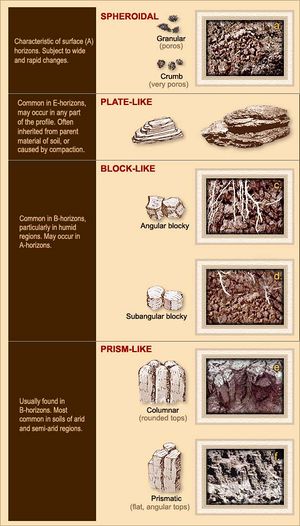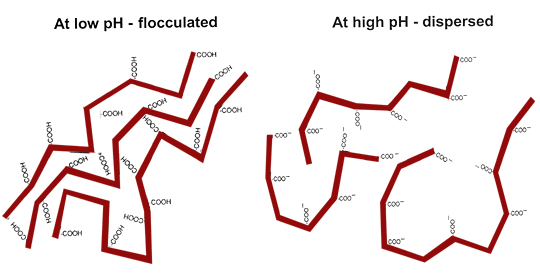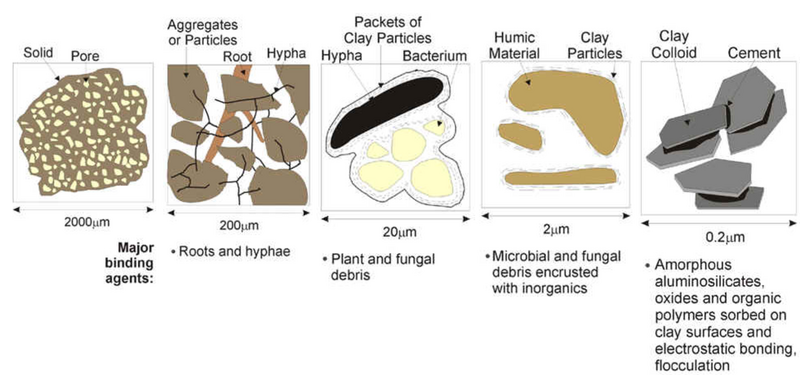LFS:SoilWeb/Interactions Among Soil Components/Soil Structure
Soil structure is the arrangement of soil particles into secondary units called aggregates or peds. Soil structure is determined by the way in which individual soil particles bind together and aggregate; therefore, aggregates affect the arrangement of soil pores between them. Soil structure has a major influence on water and air movement, biological activity, root growth and seedling emergence. Soil aggregates can be characterized in terms of their shape (or type), size (fine, medium, or coarse), and distinctness (or strength, such as strong, moderate, or weak).
The development of soil structure is enhanced by:
- Abiotic (physical and chemical) processes such as wetting/drying, or freeze/thaw
- Biotic processes, such as soil compression by roots, burrowing activities of earthworms, enmeshment of mineral particles by network of roots and fungal hyphae
Categories of Soil Structure
There are three categories of soil structure:
- Single-grained: This soil is dominated by sand particles and there is no aggregate formation. Generally, this soil has a rapid water infiltration.
- Massive: This soil has no visible structure. When dry, this soil is hard to break apart. This type of soil has a very slow rate of water infiltration.
- Aggregated: Soil particles are associated in distinct aggregates (or peds).

Types of soil structure
- Spheroidal (granular)
- Aggregates are usually between 2 mm and 1 cm in diameter and have rounded vertices. Usually present in surface horizons that have high organic matter content and abundant roots. This type of structure stimulates rapid water infiltration.
- Plate-like
- Aggregates are thin flat plates that lie horizontally. Usually present in compacted soils, or clay deposits. This type of structure stimulates slow water infiltration.
- Block-like
- Aggregates are shaped as irregular blocks of 1.5 to 10.0 cm in diameter. Angular blocky aggregates have flat faces and sharp edges, while sub-angular blocky aggregates have sub-rounded edges. This type of structure stimulates moderate water infiltration.
- Prism-like
- Aggregates are shaped as vertical columns. Aggregates that have well-defined vertical faces and sharp edges are referred to as prismatic, while those that have vertical edges near top of columns rounded (or irregular) are called columnar. These aggregates are usually present in B horizons. This type of structure stimulates moderate water infiltration.
The various structure types found in mineral soils are illustrated in the graphic to the right.
Formation of Aggregates
Aggregation = Flocculation + Cementation
Flocculation: When primary particles remain close together due to interactive forces (electrostatic, van der Waals, and/or hydrogen bonding) and form microscopic floccules.
Cementation: Stabilization of floccules by action of a cementing agent, such as organic compounds, carbonates, Fe and Al oxides, or clays.

Aggregate Formation
Importance of Soil Structure
Soil structure influences many important soil properties such as the rate of water infiltration, water retention, aeration, and drainage, because of its effects on pore size distribution. See an explanation of different types of soil pores in the SoilWeb200 Types of Soil Pores page.
Good soil structure is important for plant growth in soils with clay and/or silt and is especially important in regions subject to management. Structural strength must be considered where stresses imposed at the soil surface may cause the structure to deteriorate. The stress may be imposed by cultivation, trampling by livestock, heavy traffic from logging, etc.
